Which do you want to take into the field?
Both .30-30 Winchester and .45-70 Government have stood the test of time. Legendary might be the polite way of saying these two cartridges are old, but the truth is they are real performers.
When it comes to killing game, both are more than capable on deer and bear up to moose, bison, and elk. Chambered mostly in lightweight, fast-shooting lever-action rifles, these calibers appeal to everyone’s inner cowboy.
So, you might be asking yourself: when it comes to .30-30 versus .45-70, which is the best to use? The short answer is it depends on your intended application and a few other factors.
The .45-70 Government Development
The .45-70 Government is the older of these two cartridges. It was adopted by the U.S. Military back in 1873, a few years before the Battle of Little Big Horn was fought.
It was used in single-shot Springfield Trapdoor rifles and originally fired a 405-grain .45-caliber bullet atop 70 grains of black powder loaded in a straight-wall, rimmed case.
Caliber size and powder charge were the preferred way of naming cartridges back then, hence the name .45-70. It had a muzzle velocity of around 1,300 fps and shed energy faster than an ice cube melting on the pavement in August.
Cartridges used by the U.S. military often find themselves becoming extremely popular with the civilian population as well. The .45-70 was no different. Long after the government phased out the .45-70 Gov’t cartridge, it was still seeing use by American hunters and that remains true to this day.
.45-70 Government Smokeless Powder Loads
Even though it continued to see use after the transition was made from black powder to smokeless powder its ballistic potential was unfortunately neutered in most instances.
Because the guns originally designed to use .45-70 were black powder firearms, they couldn’t handle the higher pressures generated by smokeless powder. In turn, most smokeless loads were equivalent to black powder loads in pressure and performance.
The upside was most smokeless .45-70 ammo is safe to use in antique guns (always double-check before shooting though!). The downside is the loads leave a lot of performance on the table.
This is mitigated by .45-70 “overpressure” loads that can substantially improve the round’s ballistics, but these should only be used in modern guns that are designed to handle them.
The .30-30 Winchester Development
Winchester introduced the first smokeless sporting cartridge in 1895 and called it the .30 Winchester Centerfire or .30 WCF. It was chambered in the Model 1894 lever action creating perhaps the most popular deer hunting cartridge and rifle combination to ever grace the Earth.
Other rifle competitors like Marlin chambered the caliber in their lever-action rifles but were loathed to stamp the Winchester name on a Marlin rifle. Marlin decided to call the new cartridge the .30-30: a .30-caliber bullet over 30 grains of powder. The name stuck and we all still call it the .30-30 today.
The cartridge became the benchmark caliber for deer, but that didn’t stop hunters from using the .30-30 on pronghorn, caribou, elk, moose, bear, wolves, coyotes and any other critters and varmints between the West and East Coasts.
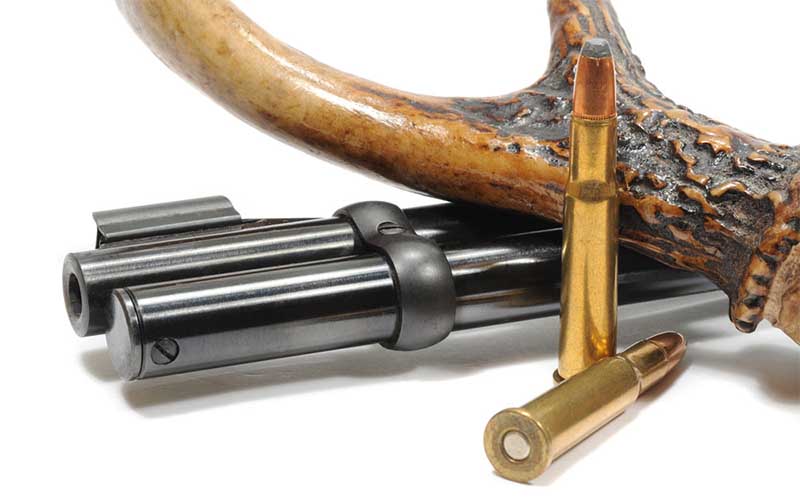
The original .30-30 round was loaded with a 160-grain soft-point, round-nose .30-caliber bullet. It had a muzzle velocity of 1,970 fps, and at modest ranges it offered plenty of power with minimal recoil.
.30-30 Vs .45-70: Modern Loads
The sweet spot of bullet weights for the .30-30 are 150- and 170-grain projectiles. Lighter and heavier bullets are available, but these two weights most easily enable the .30-30 to be a game-getter.
Factory data for modern 150-grain bullets looks something like 2,390 fps at the muzzle with 1,902 foot-pounds of muzzle energy. Heavier 170-grain bullets have a muzzle velocity of around 2,200 fps and 1,827 foot-pounds of energy at the muzzle.
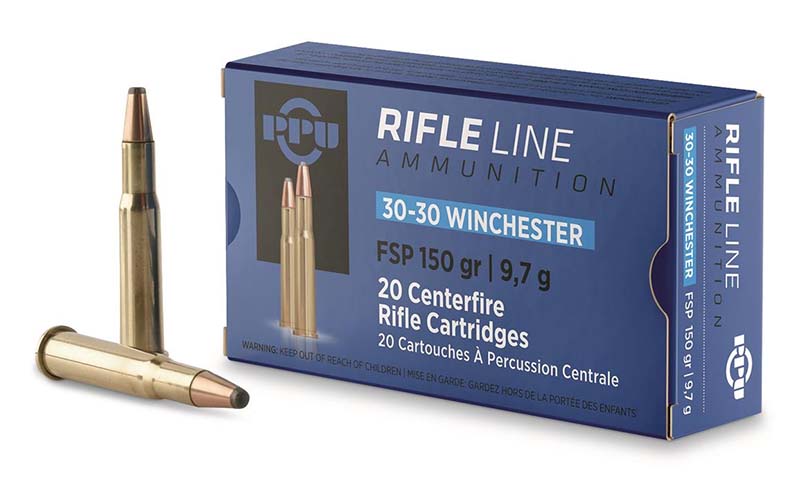
Modern .45-70 loads have more speed and punch but don’t have the legs when it comes to distance. Popular bullet weights include 300 and 405 grains, though bullet weights ranging from 225 grains up to 500 grains are available.
Modern factory loads of 300-grain bullets should provide something like 2,000 fps with a muzzle energy of around 2,665 foot-pounds.
.30-30 Ballistics
First, let’s take a look at popular .30-30 loads using factory data. All trajectory charts were made using Shooter’s Calculator with a 100-yard zero, a 1.5-inch sight height, a 10-mph 90-degree crosswind and zero corrections for atmosphere.

Looking at the chart, you can see modern Hornady LEVERevolution offers slightly better performance than the Federal Power-Shok and Winchester Power Point.
The 170- and 150-grain round-nose bullets from Federal and Winchester push through the air rather than slice through. Round-nose bullets create drag and do not cut through the air as efficiently as pointy, spitzer-style bullets.
The spitzer-style 140-grain bullet in the Hornady load more easily travels through the air giving it the flattest trajectory of all the loads. At 100 yards, the 140-grain bullet is still carrying 1,481 foot-pounds of punch. By 200 yards it has dropped 5.85 inches.
The 150-grain bullet offers slightly less energy at 100 yards (1,468 foot-pounds) and drops nearly 6.5 inches at 200 yards. The 170-grain bullet offers even less energy at 100 yards (1,355 foot-pounds) and drops over 8 inches at 200 yards.
Wind affects these bullets, too. Assuming a 10-mph wind perpendicular to your shooting spot, expect the wind at 100 yards to push the 170-grain and 150-grain bullets 1.9 inches and 1.5 inches, respectively.
The 140-grain spitzer is the least affected by the wind with only about 1.4 inches of drift, but not by a huge margin.
If the kill zone is a four-inch circle, a dead-on shot out to 100 yards will do the trick. Beyond that range, especially with stronger wind, you’ll need to adjust your aim to compensate for drift and drop.
.45-70 Ballistics
The ballistics for factory .45-70 loads show the bullet’s greater mass is both a pro and a con. It provides needed energy, but quickly loses speed as distance increases.
At 100 yards, the Remington Core-Lokt 405-grain flat-nose bullet provides 1,725 foot-pounds of energy. The Federal HammerDown 300-grain flat-nose and Hornady LEVERevolution 325-grain FTX bullet offer 1,730 and 2,159 foot-pounds, respectively.
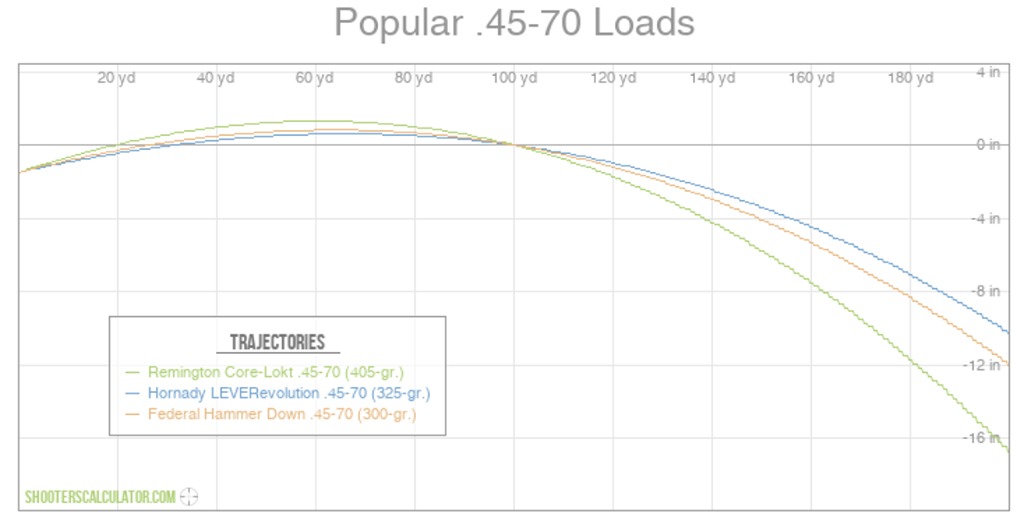
The chart data shows the modern Hornady spitzer-style bullet shoots flatter and is less affected by wind. The flat-nose bullets of the Remington and Federal loads drag through the air.
Because .45-70 bullets are heavy and have a low BC, they drop like stones as the distance increases. The wind impacts these massive bullets, too. At 100 yards with 10 mph wind, expect about 2.6 inches of drift with the 405-grain bullet, 2.4 inches with the 325-grain and 2.1 inches with the 300-grain.
At 200 yards, the bullets’ drop becomes substantial, with the 325-grain falling 10.25 inches, the 300-grain dropping nearly 12 inches and the 405-grain dropping about 16.25 inches.
.30-30 Vs .45-70: Ballistics
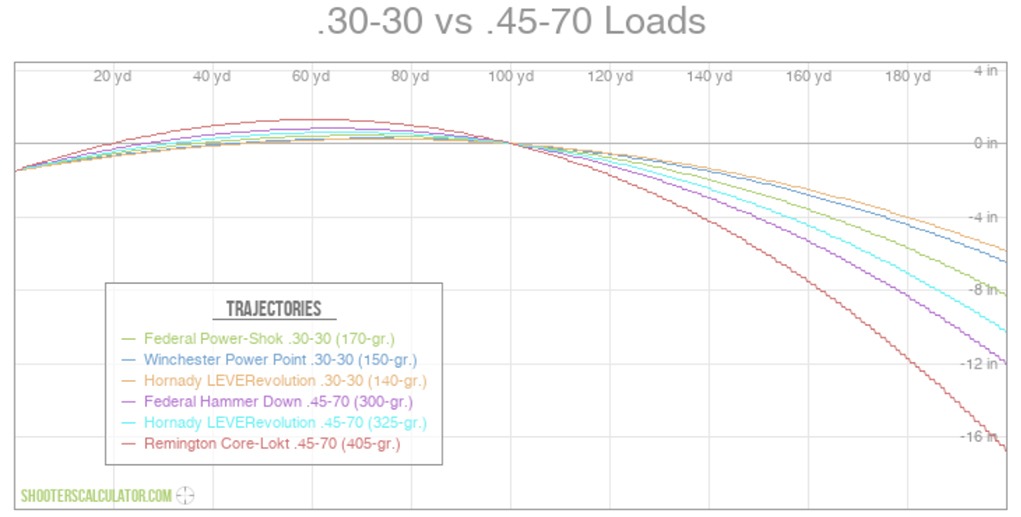
Overlaying the ballistic data for the .30-30 loads with the .45-70 loads, it becomes easy to see that the .30-30 shoots flatter than the .45-70. This is important if you plan on shooting past 100 yards as there will be less holdover with the .30-30.
The data also shows that the .45-70 offers more energy at the same distances as the .30-30. Depending on the game being hunted, that extra punch might be necessary, showing us that both cartridges excel in different areas and that each still has its place.
.30-30 Vs .45-70: Ammunition
Many factory options are available for both cartridges today. The .45-70 has the widest range of choices from target shooting and subsonic loads up to +P loads used for grizzly bear and other dangerous game.
Popular bullet weights are 300- and 405-grain options. In 405-grain loads expect a soft-point flat-nose bullet from Remington, Winchester, Sellier & Bellot, Federal, and Fiocchi. These are good options for deer, pigs, and bear. Buffalo Bore, Grizzly and Underwood produce standard and +P loads in bullet weights ranging from 225-grain up to 500-grains.
Use these if you want more penetration and stopping power on elk, moose, bison or Godzilla. If you want more distance and a slightly flatter trajectory, try Hornady LEVERevolution in 250- and 325-grain loads with polymer-tipped spitzer bullets. These have a higher BC which means they drop less and are less affected by the wind.

Neither caliber is cheap, but one advantage of .30-30 is you will spend less on ammo than you would buying .45-70. Bullet weights range from 125- to 190-grains.
Most of what you’ll find will be either 150- or 170-grain. Winchester, Remington, Federal, Prvi Partizan, Nosler, Browning, Hornady and others all load 150- and 170-grain soft-point bullets. This is your go-to ammo if your shots are at 100 yards or less and you’re gunning for deer, bear or pigs.
If you want lead-free options, Nosler, Barnes, and Underwood offer monolithic copper bullets as well.
.30-30 Vs. .45-70: Which Should You Use?
Data doesn’t lie. Both .30-30 and .45-70 are excellent game cartridges at moderate ranges. I keep my shots within 100 to 150 yards with either round.
The .30-30 offers more speed over .45-70, which means it shoots a bit flatter. The .30-30 is also less affected by wind and offers less felt recoil.
The .45-70, however, offers a massive bullet with up to 35 percent more energy compared to .30-30 Winchester. It makes bigger holes and can better penetrate the bodies of large animals.
The tradeoffs for that increase in energy are more felt recoil and a shorter effective range. That said, shooters that are sensitive to recoil should probably stick with .30-30.

There’s also the legal side of things to consider, as your state’s hunting laws might choose for you.
One reason to consider the .45-70 over the .30-30 is that the .45-70 is a straight wall cartridge, which is legal in some states for deer hunting. Since the .30-30 is not a straight wall cartridge, it is not a legal option.
If hunting regulations are not a factor, choosing between the .30-30 and .45-70 comes down to what game you are hunting.
If you hunt whitetail deer, wild pigs, and black bear at moderate distances you cannot go wrong with .30-30. It offers a flatter trajectory than the .45-70 and has far less recoil.
If you also hunt elk, bison, and moose, my choice would be a .45-70. It can easily handle medium-sized game like deer, pigs and black bear, as well as big game. You get more recoil with the .45-70 but the tradeoff is a larger wound channel and deeper penetration.
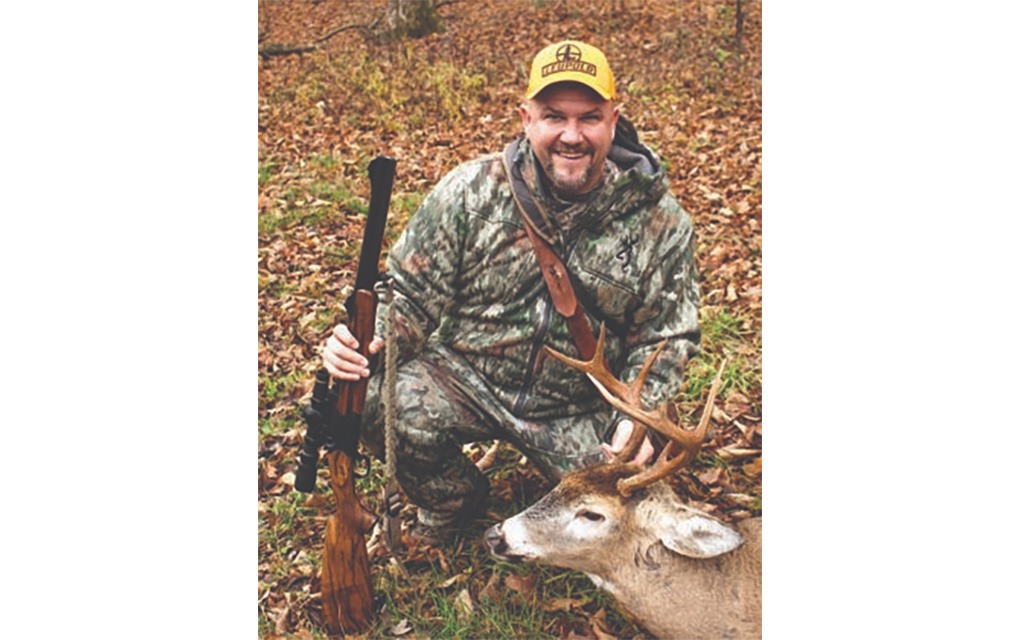
Both cartridges have taken staggering amounts of game in their lifetimes, and you can’t go wrong with either.
That said, depending on the size of the animal you’re pursuing and your anticipated shot distance, using either .30-30 or .45-70 might just be able to provide that extra bit of performance that makes the difference between hitting your mark or not.
Raise Your Ammo IQ:
Beyond The 6.5 Creedmoor: The Other 6.5 Cartridges
The Lonesome Story Of The Long-Lost 8mm
Why The .300 H&H Magnum Still Endures
.350 Legend Vs .450 Bushmaster: Does One Win Out For Hunting?
Read the full article here
